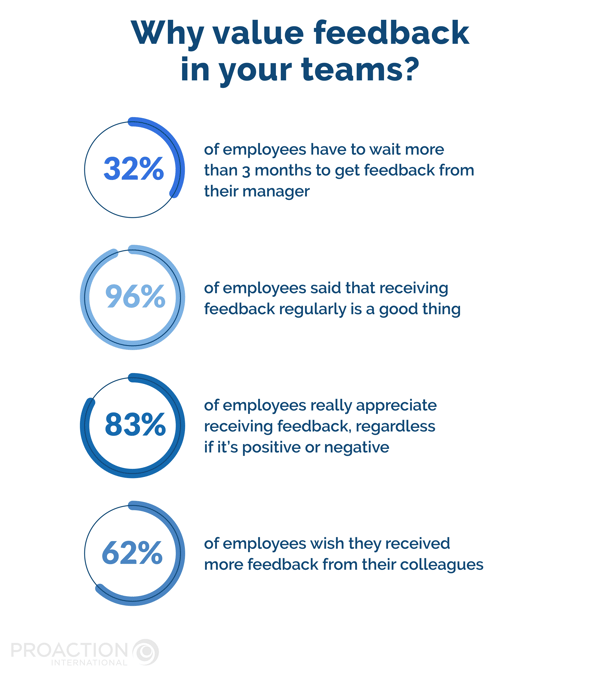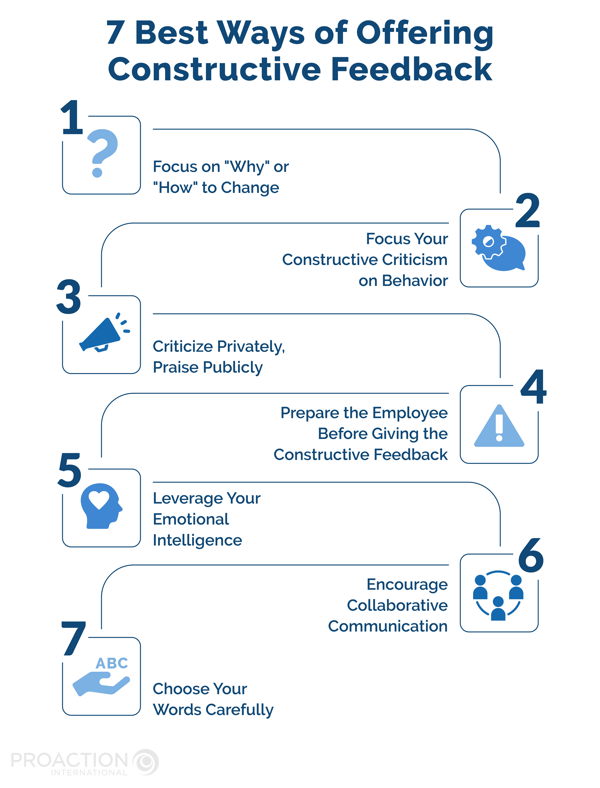What is constructive feedback?
Constructive feedback is a valuable response that focuses on improving an employee's performance. Constructive feedback is about being supportive such that your feedback influences positive behavioral change. It focuses on what needs to be improved and how the employee should make the improvement. Constructive feedback can involve comments, suggestions, or pieces of advice.
Why is constructive feedback important?
In 2021, Officevibe compiled employee engagement statistics from thousands of businesses across 157 countries worldwide, and the insights were mind-blowing. The stats say that 83% of employees value constructive feedback (praise) more than gifts. This is good news for managers because you can motivate employees by using people-centric leadership instead of material or financial perks.
While giving regular feedback may sound like too much work for managers, employees crave feedback. Research says that 72% of employees believe that their performance might improve if managers provide corrective feedback. Therefore, give constructive feedback as often as possible.
As a result, you get to:
- Improve employee engagement and morale by helping them learn from their mistakes
- Positively impact an employee's behavior
- Encourage collaboration among employees
- Boost productivity since employees will know what to do to improve their performance
- Reduce confusion concerning current performance and expectations since constructive feedback clarifies how employees should do things
- Build trust relationships with employees because constructive feedback is genuine, straightforward, and helpful

What is destructive feedback?
Destructive feedback focuses on faults, on negative behaviors and is a direct attack on the employee. The feedback is impractical, unsupportive, or disrespectful. Specific examples of destructive feedback include:
- Criticism that focuses on the word "you."
- Careless comments that an employee may consider offensive
- Workplace bullying
Destructive feedback causes conflict within the workforce, inhibits employee collaboration, and creates a toxic workplace environment. To avoid these adverse effects at your workplace, read on to discover the best ways of making your feedback constructive.
7 best ways of offering constructive feedback
Here are the best ways to offer constructive feedback to your team members.
1. Focus on "Why" or "How" to change
You can make negative feedback constructive if you frame them appropriately. The feedback should focus on the change that should occur without resulting in accusations or derogatory comments and tone. It should show why the employee has to avoid or change a particular habit.
Example of Focusing on "Why"
Suppose you've divided workers into groups A and B and assigned each group a specific task. You've noticed that group A member is always 30 minutes to 1 hour late for a while. Instead of rebuking the employee ("You are always late to report to work"), show him why it's crucial to report to work early. In this case, constantly reporting to work late makes other group members feel taken advantage of and might affect the employee's salary if the wages are hourly.
Example of Focusing on "How"
You are a project manager in a construction company. An employee didn’t do the follow-up about the project as required. Instead of "That's not how you do things here," you can try the following.
"I need you to keep me well informed regarding the project. Let's arrange a 15 minutes call every Friday for the project's updates, okay?"
2. Focus your constructive criticism on behavior
Constructive criticism focuses on the habits you want to be changed. Rather than telling an employee that they are always late to work, show them the dates they reported late. Instead of saying an employee is disrespectful, remind them of the instances they sighed and rolled their eyes when you assigned them duty. The criticism becomes constructive because it's evidence-based instead of assumptions and interpretations.
Rather than telling an individual that you want them to be a "team player", make them understand the specific behavior you expect. That way, they know what to do exactly to improve their performance.
3. Criticize privately, praise publicly
Make this point a general rule to ensure you give effective feedback. If you criticize employees publicly, in a team meeting, for example, they are more likely than not to feel humiliated and embarrassed, making the criticism less valuable. Public criticism makes people defensive, making it difficult to learn from their mistakes.
On the other hand, private one-on-one feedback makes the criticism more valuable if you deliver it with the right motive and tone. When appreciating good work, do it in public. Public praise adds weight to the constructive feedback and encourages other employees to emulate whatever was great.
4. Prepare the employee before giving the constructive feedback
You should give employees a heads-up before giving them corrective feedback. It's like giving them a disclaimer so that they are ready to handle the outcome. You can prepare the employee for the feedback with a statement like, "I'm about to tell you something that may be difficult for you to hear." Such a disclaimer makes the employee search for the truth in your response. This truth might improve the person's performance and results at the workplace.
5. Leverage your emotional intelligence
As a manager, your emotional state matters before critiquing an employee. Critiques can quickly become personal, which makes them destructive rather than constructive. For example, your feedback can easily initiate an attack on an individual if you are angry or anxious.
Understand how your response impacts you personally before giving the feedback face-to-face. After that, consider how the feedback will affect the person and the team's productivity. If you manage your feelings beforehand, you will frame the feedback properly and obtain the desired results.
6. Encourage collaborative communication
Picture this. Your organization is facing problems. As the chief supervisor, you've been instructed to chair a meeting with employees to brainstorm ideas that enable the business to make informed decisions.
If a colleague shares a thought and you disagree with it, don't shoot the thought down instantly. That's because a quick response could discourage the colleague from sharing ideas in the future. Build a company culture that fosters collaboration, values communication skills, and promotes constructive criticism instead of immediate objections.
7. Choose your words carefully
Respecting an employee's dignity makes your feedback constructive. Avoid words that put the person on a defensive end. Use "I" in your feedback, like "I'm worried about," or "I've observed" instead of "you" responses like "you never" or "you always." When framing your message, ensure your emotions are entirely out of it. Otherwise, they will derail the point you're trying to communicate.

Another way to prevent an individual from becoming defensive is by giving choices (where possible). Assume an employee is irregular in informing you about critical business projects. Instead of going nuts about it, you can ask the employee to choose an appropriate day for weekly updates. That way, you give them an option, and at the same time, you get the outcome you desire.
Proaction International Coaches Can Help You Frame and Deliver Constructive Feedback Appropriately
As a manager, giving constructive feedback to employees is essential. Praising a job well done encourages positive habits at the workplace. On the other hand, constructive critiques help employees learn from their mistakes. However, feedback can result in a toxic working environment if managers handle it poorly.




.webp)




